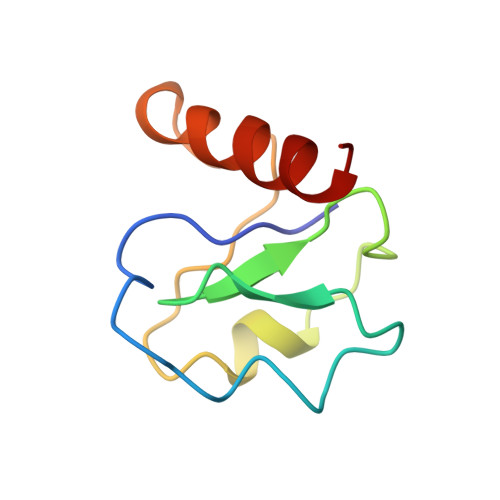Solution structure of an artificial Fe8S8 ferredoxin: the D13C variant of Bacillus schlegelii Fe7S8 ferredoxin.
Aono, S., Bentrop, D., Bertini, I., Cosenza, G., Luchinat, C.(1998) Eur J Biochem 258: 502-514
- PubMed: 9874217
- DOI: https://doi.org/10.1046/j.1432-1327.1998.2580502.x
- Primary Citation of Related Structures:
1BQX, 1BWE - PubMed Abstract:
The solution structure of the D13C variant of the thermostable Fe7S8 ferredoxin from Bacillus schlegelii has been determined by 1H-NMR spectroscopy in its oxidized form. In a variable-temperature NMR study the D13C variant was as thermostable (up to 90 degrees C) as the wild-type protein (WT). Seventy-five out of 77 amino acid residues and 81% of all theoretically expected proton resonances in the D13C Fe8S8 protein have been assigned. Its structure was determined through torsion angle dynamics calculations with the program DYANA, using 935 meaningful NOEs (from a total of 1251), hydrogen bond constraints, and NMR-derived dihedral angle constraints for the cluster-ligating cysteines. Afterwards, restrained energy minimization and restrained molecular dynamics were applied to each conformer of the family. The final family of 20 structures has RMSD values from the mean structure of 0.055 nm for the backbone atoms and of 0.099 nm for all heavy atoms. The overall folding of the WT is maintained in the mutant, except for the immediate vicinity of the new cysteine, which becomes much more similar to native Fe8S8 proteins. The two residues at positions 11 and 12, which constitute an insertion with respect to all known Fe8S8 proteins, assume a conformation that does not prevent the preceding and following residues from folding like in native Fe8S8 proteins. Clear evidence for the existence of two conformations involving almost half of the amino acid residues was found. The two conformations are structurally indistinguishable. Temperature-dependent NMR experiments show that one of them is thermodynamically more stable than the other.
Organizational Affiliation:
School of Materials Science, Japan Advanced Institute of Science and Technology, Ishikawa.

















